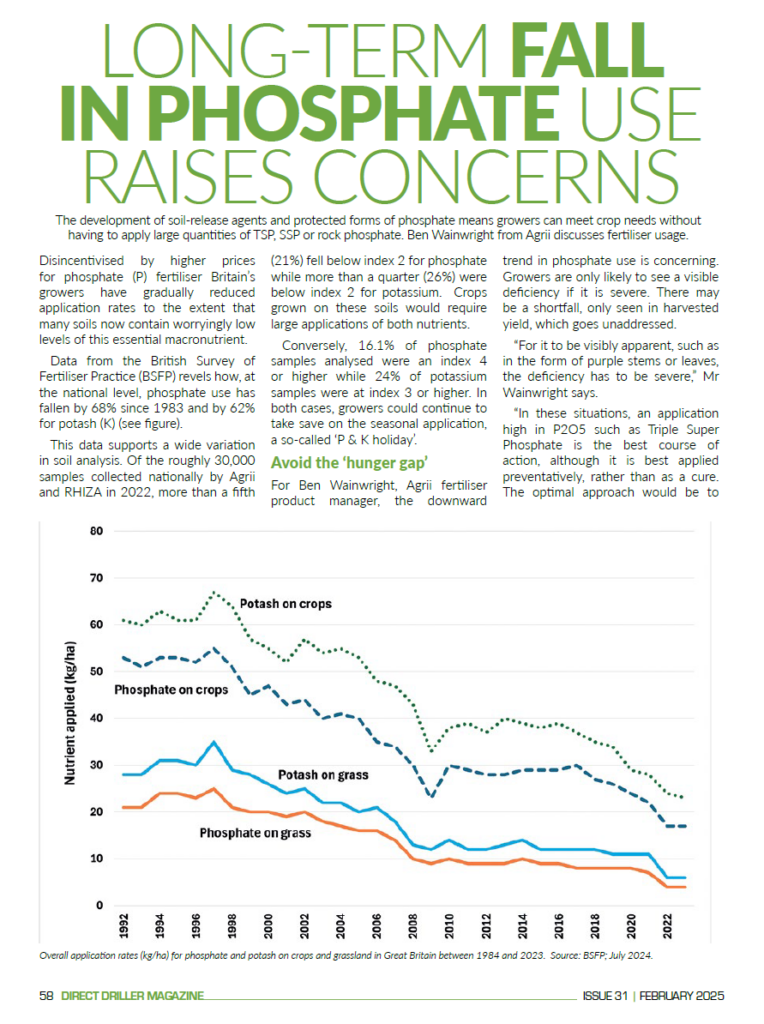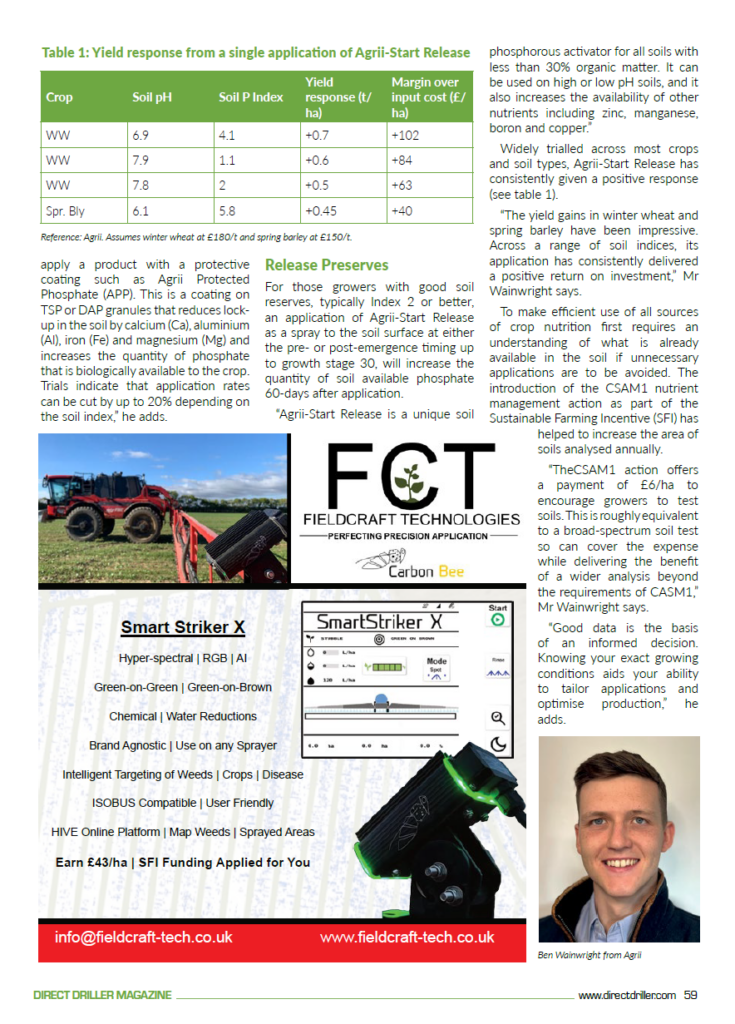The development of soil-release agents and protected forms of phosphate means growers can meet crop needs without having to apply large quantities of TSP, SSP or rock phosphate.
Disincentivised by higher prices for phosphate (P) fertiliser Britain’s growers have gradually reduced application rates to the extent that many soils now contain worryingly low levels of this essential macronutrient.
Data from the British Survey of Fertiliser Practice (BSFP) revels how, at the national level, phosphate use has fallen by 68% since 1983 and by 62% for potash (K) (see figure).

Overall application rates (kg/ha) for phosphate and potash on crops and grassland in Great Britain between 1984 and 2023.
Source: BSFP; July 2024.
This data supports a wide variation in soil analysis. Of the roughly 30,000 samples collected nationally by Agrii and RHIZA in 2022, more than a fifth (21%) fell below index 2 for phosphate while more than a quarter (26%) were below index 2 for potassium. Crops grown on these soils would require large applications of both nutrients.
Conversely, 16.1% of phosphate samples analysed were an index 4 or higher while 24% of potassium samples were at index 3 or higher. In both cases, growers could continue to take save on the seasonal application, a so-called ‘P & K holiday’.
Avoid the ‘hunger gap’
For Ben Wainwright, Agrii fertiliser product manager, the downward trend in phosphate use is concerning. Growers are only likely to see a visible deficiency if it is severe. There may be a shortfall, only seen in harvested yield, which goes unaddressed.
“For it to be visibly apparent, such as in the form of purple stems or leaves, the deficiency has to be severe,” Mr Wainwright says.
“In these situations, an application high in P2O5 such as Triple Super Phosphate is the best course of action, although it is best applied preventatively, rather than as a cure. The optimal approach would be to apply a product with a protective coating such as Agrii Protected Phosphate (APP). This is a coating on TSP or DAP granules that reduces lock-up in the soil by calcium (Ca), aluminium (Al), iron (Fe) and magnesium (Mg) and increases the quantity of phosphate that is biologically available to the crop. Trials indicate that application rates can be cut by up to 20% depending on the soil index,” he adds.

Release P reserves
For those growers with good soil reserves, typically Index 2 or better, an application of Agrii-Start Release as a spray to the soil surface at either the pre- or post-emergence timing up to growth stage 30, will increase the quantity of soil available phosphate 60-days after application.
“Agrii-Start Release is a unique soil phosphorous activator for all soils with less than 30% organic matter. It can be used on high or low pH soils, and it also increases the availability of other nutrients including zinc, manganese, boron and copper.”
Widely trialled across most crops and soil types, Agrii-Start Release has consistently given a positive response (see table 1).
“The yield gains in winter wheat and spring barley have been impressive. Across a range of soil indices, its application has consistently delivered a positive return on investment,” Mr Wainwright says.
Table 1: Yield response from a single application of Agrii-Start Release
| Crop | Soil pH | Soil P index | Yield response (t/ha) | Margin over input cost (£/ha) |
| WW | 6.9 | 4.1 | +0.7 | +102 |
| WW | 7.9 | 1.1 | +0.6 | +84 |
| WW | 7.8 | 2 | +0.5 | +63 |
| Spr. Bly | 6.1 | 5.8 | +0.45 | +40 |
Reference: Agrii. Assumes winter wheat at £180/t and spring barley at £150/t.
To make efficient use of all sources of crop nutrition first requires an understanding of what is already available in the soil if unnecessary applications are to be avoided. The introduction of the CSAM1 nutrient management action as part of the Sustainable Farming Incentive (SFI) has helped to increase the area of soils analysed annually.
“TheCSAM1 action offers a payment of £6/ha to encourage growers to test soils. This is roughly equivalent to a broad-spectrum soil test so can cover the expense while delivering the benefit of a wider analysis beyond the requirements of CASM1,” Mr Wainwright says.
“Good data is the basis of an informed decision. Knowing your exact growing conditions aids your ability to tailor applications and optimise production,” he adds.

